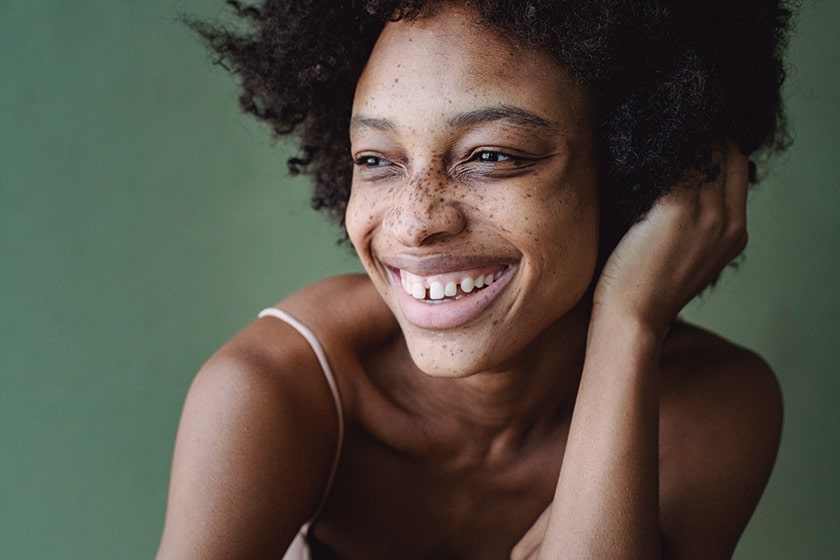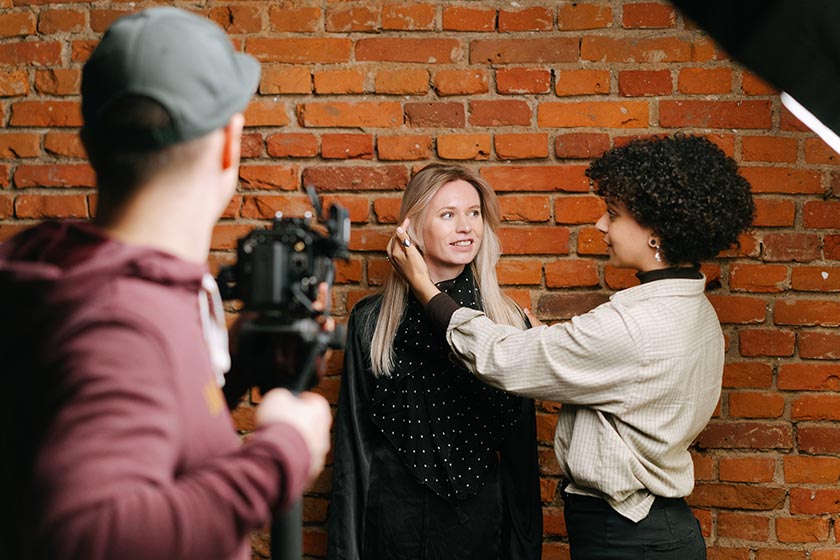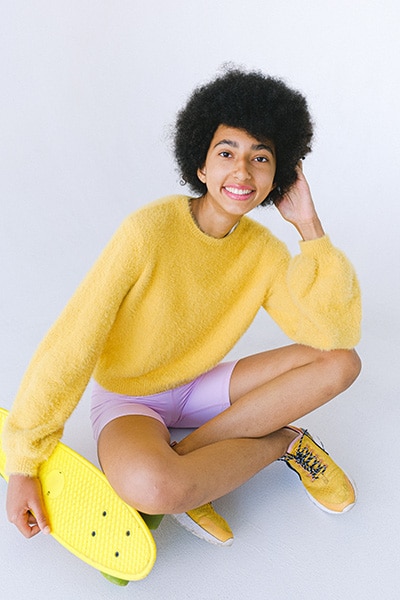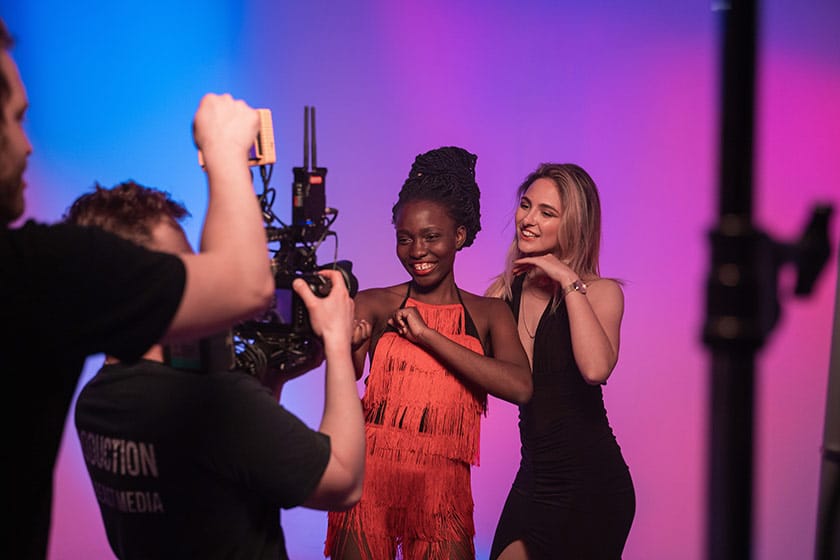Top tips to help clients feel confident in your photography studio.
January 27th, 2023
Getting your clients to loosen up in front of the camera can be tricky at the best of times. Throw in some other variables, like an unruly teen who is too busy brooding to crack a smile or someone who is feeling self-conscious about their appearance, and honestly, you have your work cut out for you. But, you’re not alone in this struggle.
Thankfully, we’ve collected some simple ways you can help your clients feel comfortable and confident in front of the camera, whether that’s achieved through guiding your subject with directions and language, simple portrait posing tips, or icebreakers to help your clients feel relaxed – we have it all here for you.
Some of this might seem silly, simple, or even obvious, but it’s better to be prepared with plenty of tools at your disposal in order to keep your clients happy. When people hire you they are mostly thinking about what the photos will look like afterward, but the real service you’re providing is your expertise and preparedness. The thing that will stick with your client the most is how you make them feel during the shoot.
Moreover, the more confidence you can have behind the camera, the more likely your client will feel confident in front of the camera. So, let’s jump into some examples of ways you can make your client feel more comfortable and at ease in the studio or on location with you.

Preparation and the in-studio experience.
Admittedly, the term in-studio experience might seem vague and undefined, or possibly even nebulous. Basically, these are methods you can use to aid your clients in your studio and create a positive experience. Coming into someone’s space is difficult at the best of times and we are all doing our best to reconnect to our normal habits when it comes to socializing. Add the dynamic of having a camera in your face and it can be downright terrifying for some clients.
Before a session.
There’s no way to know what someone’s social preferences are before getting to know them personally, so consider this when welcoming clients to your studio. We would also recommend getting to know your clients a little before the photoshoot by way of a pre-shoot call or meeting, and possibly a questionnaire. This can lay a foundation of familiarity and put them at ease before the session starts.
Referring to certain body parts.
When doing certain types of photography, like modeling or boudoir, you will probably want to refrain from using crude language when referring to someone’s body, even if it is related to a specific pose you have in mind. Instead of saying, something crude like, “Push your ass out,” say something like, “Push out your hips.” Likewise, instead of calling attention to someone’s double chin or rolls, ask them to extend their neck or spine and stand tall. Always use language that is positive and encouraging, and makes your subject feel confident and powerful.
What to do when you need to adjust clothing.
Sometimes as the photographer, you will need to do some quick adjustments to someone’s clothing, even if you have an assistant or large production crew because not everyone is looking for the details you are (including stylists). If you need to make some sort of adjustment to your subject’s clothing, ask first, and do your best to explain what you are doing and why, in a friendly way. Maybe the shirt is tucked in a way that looks messy or unflattering. Most importantly, always offer your client to adjust it themselves first, even if it seems innocuous.
What to do when you need to adjust hair.
For some people, their hair is very important to them, and rightfully so. People have many different types of hair. So, even if you’re experienced in dealing with a range of different hair types and styles, or have a background in hairstyling, you will want to check with your subject about touching their hair or making any adjustments first. Ask for permission, not forgiveness.
Be nice!
Some things just can’t be replaced, and being nice to your clients is one of them. This could be as simple as offering a glass of water to your client or picking up a coffee order. But, music, time management, and being understanding are always going to be your best bet to help your client know they are in good hands. As we mentioned earlier in this article, what sticks with people is how you make them feel. You could deliver the most stunning photos ever taken, but if you’re unpleasant with them or make them feel self-conscious, it will still ruin their experience.
Refreshments.
This was teased out a bit in the last tip, but having refreshments like snacks and water, or even wine or beer can help get your client comfortable for the photoshoot. If they don’t want anything then just ask if there is anything else you can get them that they might prefer instead.
Make sure the studio is at a comfortable temperature.
Making sure the temperature of the space you are shooting in is not too hot or cold is not only going to make your client feel better taken care of when you are doing the shoot, but it will often lead to better results in camera too. Beads of sweat and bluish skin tones are easily dealt with by avoiding extreme hot and cold conditions, and aiming for a temperature that will be comfortable under studio lights. The ideal temperature range will also take into account the type of clothing your subjects will wear; boudoir clients or newborns will generally need a warmer space than business headshot clients wearing formal suits. An optimal temperature will result in less editing, which means you can be faster during post-processing and often achieve better results. When your client is at a comfortable temperature they will also feel more relaxed, and you will get better, more natural expressions out of them.

Portrait poses.
Posing is an art form in itself. Experienced models will showcase this in a way no one else really can, and it can be physically strenuous, too. It’s also something many people are inexperienced with. So, if you can have some quick tips on how people can level up their posing in the studio your subject will feel more confident and that will lead to better results in your images.
Triangles for softness.
Depending on the type of photoshoot, sometimes clients want a softer look, traditionally associated with feminine poses. Creating triangles with their arms will help accentuate a sense of softness in your subject. A few simple poses for this are placing hands on the hips at the side, or hands together with arms raised gently over their head and framing the face.
Squares for confidence.
Just like with triangles, sometimes your subjects will want a more confident or powerful look, traditionally associated with masculine poses. Having your subject cross their arms, place their hands in their pockets with arms straight, or legs shoulder width apart facing and looking straight at the camera will give a more confident feeling to your images.
Side profile.
The side profile can be used in different ways depending on your subject. If someone has long, flowy hair, get them to gently drop the hair letting it fall naturally behind the head with their arms arched over head for a glamorous side profile. You can also have the subject put the hand closest to you in their pocket for a more stoic or contemplative side profile.
Hands.
People often don’t know what to do with their hands when there’s a camera in front of them. They don’t need to make profound gestures, but giving them some guidance on where to put their hands, or giving them an action to do will help your images feel more natural. Even something simple like having thumbs sticking out of their pockets with the rest of their hands inside the pocket will help. It’s those little details that will take the poses over the top.
Mix it up!
Even if you think you might know, or have spoken to your client about the type of motion they want in their images beforehand, don’t be afraid to change things up on the spot if it seems right. No need to be rigid about it! Sometimes a little pivot or tweak of a pose in a way the subject isn’t used to presenting themselves can create more dynamic results.
Stance.
Poses all start from where and how your subject has their feet placed. Be sure to encourage your subject to widen or shorten their stance, and shift weight from one hip to the other to help inspire their body to move into different poses. Don’t be afraid to have clients make small movements with a part of their body, such as their hands or the direction of their gaze, to keep a pose from feeling stale and forced.
If you’re feeling stuck in a rut or out of ideas prior to a session, our collection of portrait photography tips will come in handy.

Studio session icebreakers.
Sometimes people just have their guard up – they may be nervous, self-conscious, or just not 100% in the mood to jump in front of a camera. The reason doesn’t really matter, but as the photographer you should do what you can to help your client loosen up. Getting in front of a camera is scary for a lot of people, even if they have done it countless times before. So, try and smooth things out with a few of these icebreakers.
Play music during the shoot.
Music is a powerful art form that can evoke a lot of memories, quickly change people’s mood, or even help someone feel more at home in a space. Sometimes all someone needs is their favorite song to forget they are currently being photographed, or to give them the boost of energy, the second wind they need to get to the desired headspace.
Jokes.
Depending on your personality and the type of shoot, jokes are another easy way to get your client to loosen up. Sometimes, with the right sense of humor and some good timing, you can even get some really genuine and enthusiastic candid smiles. Keep it light and fun! You will get better images when people feel relaxed, and happy. No need to make your session with them too stuffy.
Break time.
Sometimes your client might need a break for a variety of reasons. Maybe they feel stressed and need to talk about a minor inconvenience that occurred earlier in the day, maybe they need a bathroom break, or maybe they just need a minute to mentally and emotionally collect themselves before any more shooting. Whatever it is, make it abundantly clear that it is okay for them to do so at their leisure.
Get to know them.
We can’t stress this enough; the oft-quoted line about people not recalling what you said, but how you made them feel easily applies to a photo shoot. Unless you are a nationally-known name in the industry, people don’t care as much how good you are at what you do if you are a little too standoffish or quiet. Clients will value what you do a lot more if you show them that you in turn value them, their time, effort, and energy. So be sure to ask someone what they take inspiration from, what they like to do in their spare time, how they got started in their industry, or anything else that shows you have a genuine interest in them beyond a timely payment of the session fee.
Praise.
Praise your clients for what and how they are doing in front of the camera. If they go off-script and start doing things that are really natural for them and working in front of the camera, let them know that! If you do, they probably won’t be able to stop themselves cracking the elusive genuine smile. Not to worry if they don’t come up with it right away though, just keep it up. Shower them with compliments. On the flip side, if things aren’t working for a certain pose, don’t be afraid to give that pose less time, even while you continue the flow of positive comments. Simply shift to something new; avoid saying “this isn’t quite working.” Always keep your language and energy positive to keep your client in that same space.


